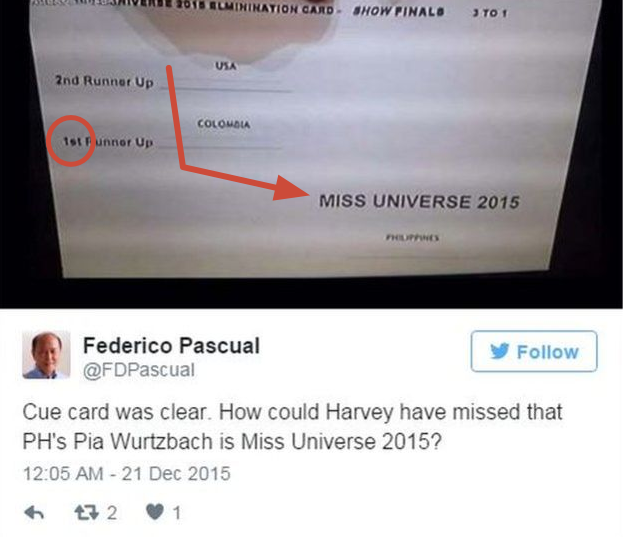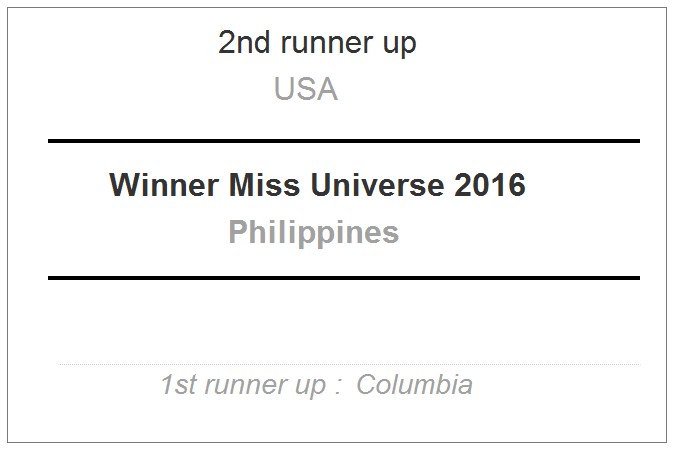I see three major issues in the described situation; two are related to the card as shown, and one is inherent to the situation.
The first issue related to the card as shown is that the information being presented is a list of three items, but the card makes it look more like a list of two items plus some unrelated, extra information.
To treat this issue, the items should be formatted in a comparable way. That does not mean the same way; the items can use different font sizes, for instance, to highlight the winner. The important part is that the items have something in common - the same kind of bullet point, the same kind of frame, the same kind of layout ... none of this is the case in the card as shown, which is why the first two items on the card seem to form a pattern there, and the third item completely breaks out of this pattern. As this is contrary to expectations of the reader, it can easily lead to mistakes.
The second issue is that each of the items in the list has a specific meaning (1st, 2nd and 3rd winner), but while technically, all labels are provided, they are ambiguous (MISS UNIVERSE 2015 is indeed the label for the bottommost item, but could just as well be the title of the whole card - and the formatting and positioning do not help).
This could be fixed by making each label clearly indicate that it is indeed a label - e.g. by something simple as putting a colon behind it, and possibly always placing it left of the value it denotes. On top of that, choosing less ambiguous texts (e.g. winner instead of Miss Universe 2015) is adviseable.
The third issue, which is inherent to the situation, is that in the aforementioned list of three items, the speaker has to consider two conflicting orderings of items, both of which can intuitively be mapped to the order of items:
- the ranking of the winners (winner - 1st runner-up - 2nd runner-up)
- the order of reading out the winners (2nd runner-up - winner - 1st runner-up)
Now, one could argue to drop one of these orderings. However, I think that is not reasonable:
- The reading order cannot be dropped. If one leaves that bit of information away, the host is essentially invited to mix things up compared to the original plan in the heat of the moment.
- The ranking of the winners cannot really be dropped, either. Unless the host is just reciting a pre-fabricated text (which is somewhat unlikely, given that the cue card only contains some keywords rather than complete text), they probably choose their concrete words as they go. For that to work, it seems important that the host have a mental model of what they are talking about, i.e. the ranking of the chosen winners.
Hence, both orders have to be incorporated into the card. It can be achieved by using positions for one of the aspects, and arrows for the other one.
As a result, I would choose to indicate the ranking by means of the position. This seems more logical to me as readers see at one glance which one of the three items they are reading. Assigning different positions than the numbers 1st, 2nd, and 3rd winner, or top, middle, and bottom winner, or whatever terms the host might be thinking of, is confusing, comparably to the well-known read out colour names coloured differently than what they say pictures.
Conversely, for the reading order, the host just has to know where they are and what is next. There does not need to be a clear sense of a numerical position in the list, while the sequence aspect, transitioning from one item to the next, is much more prevalent. Therefore, this aspect lends itself to being expressed with arrows.
So, my final recommendation looks like this:

This card indicates the reading order with arrows that the host can easily follow, while at the same time, the mental model of the subject matter at hand, the ranking of the contestants, is represented by the positions of the list items (and further supported by font sizes).
A few additional points to note:
- The initial arrow is the only one that starts out of nowhere, the others are directly connected to the frames of preceding items for a clear visual contrast.
- Moreover, the initial arrow starts in the top left corner, the presumed start of the page in the reading direction of the host, so it is hard to miss that point of entrance1.
- The placement of the arrows alternates between left and right, so even if the host somehow loses track of which box they were at, they might still know on which side the next arrow was supposed to be (similar to when you are reading a book, and you don't remember the exact page you are on, but you are always somehow aware whether you're on a left or a right page).
1: Given that the original cue card contains only superficial information, I am assuming that there is some minimal briefing for the host. If the card is supposed to be entirely self-explaining, I would consider adding the text read along these arrows or something like that to the beginning of the initial arrow.
![[http://www.people.com/article/steve-harvey-host-miss-universe-20161]](https://i.sstatic.net/EXncO.jpg)












